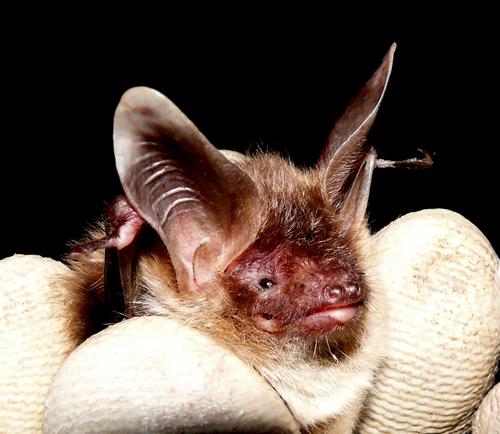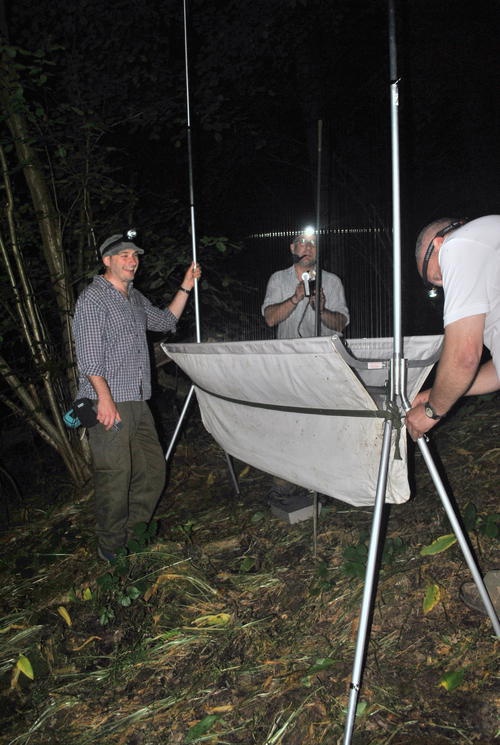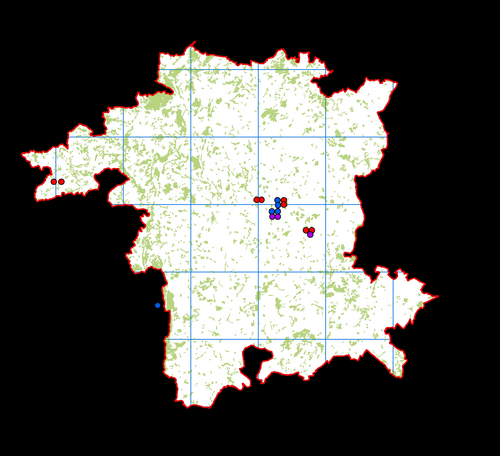The National Bechstein’s Bat Survey and Beyond
Jane Sedgeley, James Hitchcock & Johnny Birks
In Worcestershire Record 14:38, April 2011, James Hitchcock reported on the Bat Conservation Trust’s Bechstein’s Bat Project launch in Worcestershire and presented preliminary survey results from 2010. Since then we’ve completed our second survey season and the National Project has come to an end – but with some very exciting results for Worcestershire.
The Project aimed to map the UK distribution of the rare and elusive Bechstein’s bat, Myotis bechsteinii (Fig. 1.); to gather more information about the species’ range and habitat associations; and to identify conservation hotspots. Based on pilot work in south-east England (by Dr David Hill and Frank Greenaway), selected woodlands in southern England and south Wales were surveyed using a specialised trapping technique (Fig. 2.) operated by county based voluntary bat groups. Ten local bat groups took part in the project: North Buckinghamshire, Cornwall, Devon, Dorset, Gloucestershire, Kent, Oxfordshire, Somerset, Surrey and Worcestershire. In each county the targeted woodlands (one per 10×10 km square) were surveyed over two summer seasons.
Overall, between 2009 and 2011, a total of 199 target woodlands were surveyed in which 838 bats of 12 species were caught, identified and released. These included 57 Bechstein’s Bats (29 females and 28 males) at 37 sites. The records collected in Buckinghamshire and Worcestershire are now the most northerly UK records for breeding females of this species (Miller 2011).
In Worcestershire 18 woodlands were surveyed in 2010/2011. Eight Bechstein’s Bats were caught at four different sites. Breeding females and juvenile bats (born that season) were caught at Grafton Wood (owned and managed by Worcestershire Wildlife and Butterfly Conservation), Romers Wood (owned and managed by Herefordshire Nature Trust), and Oakley Wood near Droitwich. A further adult male was caught at a fourth site, but this woodland is not being named as it is in private ownership and has no public access.
Based on this success, the Bat Conservation Trust gave permission to extend the survey to investigate potential breeding hotspots. Could we find breeding female Bechstein’s Bats using other woodlands close to Grafton and Oakley Woods in the old ‘Forest of Feckenham’ area? Yes we could! We surveyed a further five woodlands and found Bechsteins’s at two of them. An adult male and juvenile female were caught at Trench Wood (owned and managed by Worcestershire Wildlife Trust) and an elderly male and a non-breeding female at the privately owned Little Goosehill Wood (no public access).
These additional surveys brought our grand total in Worcestershire to23 woodlands surveyed, 160 bats caught, comprising at least 11 bat species with 12 Bechstein’s Bats found in six different woodlands (Fig. 3.). Not only did the project reveal that Bechstein’s Bats are more widespread in Worcestershire than previously known, it also provided valuable information on a range of other rare or under-recorded woodland bat species frequently overlooked by more conventional survey techniques. For example, we now have 25 new records for Whiskered Bat Myotis mystacinus, a species very under-recorded in the county because its echolocation calls are practically indistinguishable from those of other Myotis species so it can only be indentified with any confidence in the hand.
So what next? Worcestershire Wildlife Trust has secured a grant from the People’s Trust for Endangered Species to work in conjunction with ecologists Johnny Birks and Eric Palmer, in conjunction with the Worcestershire Bat Group, to conduct a radio-tracking project this summer entitled: Bechstein's Bat – a study on the population size, foraging range and roosting ecology at Grafton Wood SSSI, Worcestershire. The main aims of the project are to build on the findings of the initial Bechstein’s Bat Surveys in order to expand our knowledge of the foraging and roosting patterns of the speciesin managed woodlands.
Management at Grafton Wood is currently very active, with wide rides and 12 acres of coppice providing a good deal of open space among the predominantly closed-canopy. Results from the forthcoming radio-tracking study will be used to produce a report to inform future management decisions at Grafton and other woodlands. The report will offer habitat management options designed to balance current conservation objectives with the desire to establish and maintain the favourable conservation status of Bechstein's Bat populations.
It’s certainly going to be a very interesting and busy summer. We hope to present our results in a future issue of Worcestershire Record, so watch this space for the next instalment and see how we got on.
Reference
Miller, H. 2011.Bechstein’s Bat survey– final report. Bat Conservation Trust. Downloadable from: http://www.bats.org.uk/data/files/publications/Bechsteins_bat_survey_final_report.pdf (accessed 9th April 2012).
Images
Fig. 1. Bechstein’s Bat Myotis bechsteinii. Jane Sedgeley
Fig. 2. Setting the harp trap used to catch Bechstein’s Bat. Jane Sedgeley.
Fig. 3. Sites in Worcestershire where Bechstein’s Bat has been recorded. Mike Glyde


